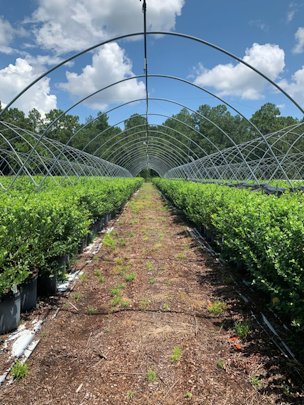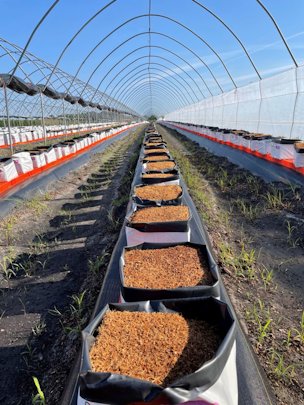Southern highbush blueberry plants are growing in containers filled with a mix of pine bark, coconut coir and perlite.
These
soil characteristics are not common in many parts of the world. Thus,
blueberries have traditionally been grown with soil amendments such as
pine bark and elemental sulfur. The use of soilless substrates is a
natural evolution in this process. Soilless substrates are composed of
organic fibers and coarse materials that are mixed to create ideal
rhizosphere conditions for plants, including optimal water and nutrient
availability, and absence of soilborne pathogens.
The nursery
industry has been using soilless substrates to produce young plants for
decades. The new trend is for high-value crops, such as small fruits,
to rely on soilless substrates for the entire production cycle.
However, nursery substrates and small fruit substrates are different.
Nursery substrates generally have high water-holding capacity and
relatively low porosity. These substrate characteristics favor young
plants with root systems that are small and still developing.
Additionally,
nursery substrates are not meant to be used for long-term production.
Some nursery crops spend as little as 21 days in their substrate before
transplant, whereas blueberry bushes can take up to four years to reach
peak productivity. Nursery management practices are very different from
management practices in a fruiting field.
Container selection
Container
size and shape are important decisions for growers interested in using
soilless substrates. The first generation of substrate-based blueberry
farms used large nursery pots with 10- or 13-gallon capacity. These
large containers were costly to fill, and the large root volume did not
improve plant growth or productivity.
Nowadays, 5- or 6-gallon
containers with abundant drainage are becoming more popular. Drainage
holes or grills at the bottom and sides of the pots increase substrate
aeration and promote root health. Pot “legs” that lift the plant from
the subtending soil are also used for these means.
Many growers
also use bags instead of pots. Substrate bags can be purchased
prefilled with substrate, which reduces the amount of labor needed to
start a field. Whether in pots or bags, the small rooting volume allows
for plants to be spaced very close to one another, achieving plant
densities up to 2,900 plants per acre.

Southern
highbush blueberry plants grown in containers can be closely spaced,
achieving very high plant densities and commercial yields in the first
year of production.
Substrate compositionThe
largest components (by volume) in soilless substrates are organic
fibers such as sphagnum peat moss, pine bark and coconut coir. These
fibers give the substrate its water- and nutrient-holding capacity. The
water-holding capacity refers to the substrates’ ability to retain
water in microscopic pores where plant roots can access it.
Since
substrate-based production systems usually use fertigation, the ability
to hold water directly impacts the availability of dissolved nutrients
for plant uptake. Coarse materials like perlite, coconut pit and
biochar are also used in soilless substrates. These materials usually
have large particle sizes (> 5 millimeters), which increase
substrate aeration and drainage. The relative contents of fibers to
coarse materials determines the substrate air-filled porosity.
Substrates for blueberry production generally have >30% air-filled
porosity, compared with nursery substrates where the target is 10% to
20%.
Substrate composition can also affect the native pH of the
substrate. Blueberry bushes prefer substrate pH in the range of 5.5 to
6.5. The pH is lowest in substrates composed of pine bark, highest in
substrates composed of coconut coir and intermediate in substrates
composed of sphagnum peat moss. However, soilless substrates do not
have high pH buffering capacity. So, their pH can change rapidly
according to the pH of irrigation water or fertigation solution and
plant nutrient uptake. Water carbonate and bicarbonate concentrations
(collectively called alkalinity) should also be considered when
managing substrate pH.

Grow
bags filled with coconut coir are ready to be planted with southern
highbush blueberries. Some blueberry growers are replacing pots for
bags filled with soilless substrates.
Decomposition concern
A
current concern among blueberry growers who use soilless substrates is
decomposition. Organic materials decompose rapidly in the warm and
moist conditions inside the pot or bag. Decomposing fibers and coarse
materials consume nitrogen, creating competition for this nutrient with
the plant. Additionally, particles get smaller as they decompose,
changing substrate water-holding capacity, porosity and drainage as the
substrate gets older.
Decomposition rates vary depending on the
initial status of each organic material. Growers overseas (where
substrate-based production started earlier than in the Southeast)
usually keep plants in the same substrate for up to five years, but
there is a lot of interest in researching practices to “rejuvenate” the
substrate.
Management and productivity
Management
is key to achieve the high plant vigor that characterizes
substrate-based blueberry production. Most substrate farms use two or
more emitters per container and aim to maintain drainage at 10% of the
total water input to achieve uniform substrate moisture.
The
solution that drains from the containers (leachate) provides a good
representation of the substrate chemical conditions. Therefore,
periodic leachate collection and analysis is used to monitor substrate
pH and electrical conductivity. Where water salinity content is high or
heavy fertigation regimens are used, salinity buildup in the substrate
can be a problem. Thus, the ability to cycle between irrigation and
fertigation events is useful to percolate salts out of the containers
when necessary.
Appropriately managed soilless substrates
provide the plant with optimal conditions to grow. In recently
published University of Florida research (see
doi.org/10.1016/j.scienta.2022.111149), plants were observed that reach
“mature” size and productivity 10 months after planting. Year one and
two yields varied per variety, but they surpassed field production
expectations both on a per-plant and a per-acre basis. Berry quality
was not affected by this significant increase in productivity.
Ultimately,
while blueberry cultivation in soilless substrates requires investment
and intensive management, research results and the experience of many
growers in the Southeast suggest that this system is a viable
alternative.
Gerardo H. Nunez is an assistant professor of horticulture at the University of Florida in Gainesville.


